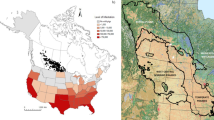Abstract
Landscape degradation and habitat fragmentation present one of the most pressing environmental issues associated with human development and the overuse of resources. Ecological networks are claimed to be effective for maintaining and improving landscape connectivity. Although there have been several methods of designation (such as the target species method), the present study builds a regional ecological network via a landscape ecological approach for the purpose of enhancing and restoring landscape connectivity. Using ArcGIS overlay and least-cost path algorithms, the study integrated relevant environmental and socioeconomic data into GIS projects to find optimal solutions for establishing a regional ecological network to act as a framework for improving landscape connectivity. After the addition of riparian protection areas and stepping stones, the resulting landscape configuration map depicts a potential approach to regional ecological connectivity. Further studies are needed, such as integrating this regional nature protection conceptualization with the urban development land use framework.








Similar content being viewed by others
References
Anderson R, Hardy EE, Roach JT, Witmer RE (1976) A land use and land cover classification system for use with remote sensor data. USGS Professional Paper 964. Washington, DC, USA
Battisti C (2013) Ecological network planning—from paradigms to design and back: a cautionary note. J Land Use Sci 8:215–223
Beier P et al (2006) South coast missing linkages: restoring connectivity to wildlands in the largest metropolitan area in the USA. In: Crooks KR, Sanjayan M (eds) Connectivity conservation. Cambridge University Press, New York, NY, pp 555–586
Beier P, Majka D, Spencer W (2008) Forks in the road: choices in procedures for designing wildlife linkages. Conserv Biol 22:836–851
Beier P, Spencer W, Baldwin RF, McRre BH (2011) Toward best practices for developing regional connectivity maps. Conserv Biol 25:879–892
Boitani L, Falcucci A, Maiorano L, Rondinini C (2007) Ecological networks as conceptual frameworks or operational tools in conservation. Conserv Biol 21:1414–1422
Department of Land and Resources of Guangdong Province (2013) Pearl River Delta Land Use Map in Pearl River Delta Atlas. Guangdong Map Publishing House, Guangzhou, China (in Chinese)
Dewan AM, Yamaguchi Y (2009) Land use and land cover change in Greater Dhaka, Bangladesh: using remote sensing to promote sustainable urbanization. Appl Geogr 29:390–401
ESRI (2008) Arc Info 9.3 Software. Environmental System Research Institute, Redlands
Forman RTT (2008a) The urban region: natural systems in our place, our nourishment, our home range, our future. Landsc Ecol 23:251–253
Forman RTT (2008b) Urban regions: ecology and planning beyond the city. Cambridge University Press, Cambridge
Harrison RL (1992) Toward a theory of inter-refuge corridor design. Conserv Biol 6:293–295
Hepcan CC, Ozkan MB (2011) Establishing ecological networks for habitat conservation in the case of Çeşme–Urla Peninsula, Turkey. Environ Monit Assess 174:157–170
Hoctor TS, Carr M, Zwick P (2000) Identifying a linked reserve system using a regional landscape approach: the Florida Ecological Network. Conserv Biol 14:984–1000
Jongman RHG (2003) Ecological networks and greenways in Europe: reasoning and concepts. J Environ Sci 15:173–181
Jongman RHG (2004) Ecological networks and greenways: Concept, design and implementation. Cambridge University Press, Cambridge
Knaapen J, Scheffer M, Harms B (1992) Estimating habitat isolation in landscape planning. Landsc Urban Plan 23:1–16
Opdam P, Steingröver E, Van Rooij S (2006) Ecological networks: a spatial concept for multi-actor planning of sustainable landscapes. Landsc Urban Plan 75:322–332
Singleton P, Gaines W, Lehmkulhl J (2002) Landscape permeability for large carnivores in Washington: a geographic information system weighted distance and least-cost corridor assessment. Research paper PNW-RP-549. U.S. Department of Agriculture Forest Service, Portland, Oregon, USA
Spencer WD, Beier P, Penrod K, Parisi M, Pettler A, Winters K, Strittholt J, Paulman C, Rustigian-Romsos H (2010) California essential habitat connectivity project: a strategy for conserving a connected California. Report. California Department of Transportation and California Department of Fish & Game, Sacramento, California, USA
Théau J, Bernier A, Fournier RA (2015) An evaluation framework based on sustainability-related indicators for the comparison of conceptual approaches for ecological networks. Ecol Ind 52:444–457
Theobald DM (2006) Exploring the functional connectivity of landscapes using landscape networks. In: Crooks KR, Sanjayan M (eds) Connectivity conservation. Cambridge University Press, New York, pp 416–443
Weber T, Sloan A, Wolf J (2006) Maryland’s green infrastructure assessment: development of a comprehensive approach to land conservation. Landsc Urban Plan 77:94–110
Weng Q (2002) Land use change analysis in the Zhujiang Delta of China using satellite remote sensing, GIS and stochastic modelling. J Environ Manag 64:273–284
Author information
Authors and Affiliations
Corresponding author
Rights and permissions
About this article
Cite this article
Guo, Y., Liu, Y. Connecting regional landscapes by ecological networks in the Greater Pearl River Delta. Landscape Ecol Eng 13, 265–278 (2017). https://doi.org/10.1007/s11355-016-0318-2
Received:
Revised:
Accepted:
Published:
Issue Date:
DOI: https://doi.org/10.1007/s11355-016-0318-2




